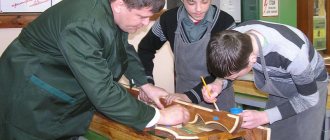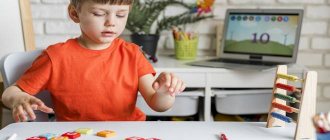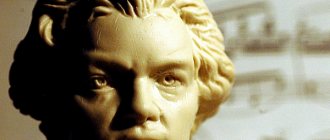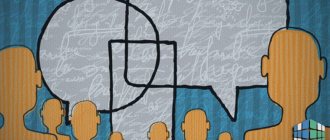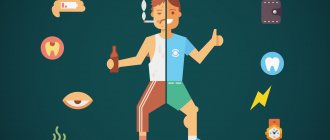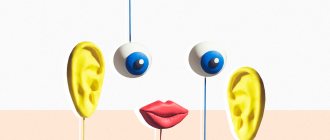What determines a person’s life outcome and success? Of course, these are the skills and abilities that he possesses. At the same time, it is extremely important to understand that they can and should be mastered and developed at any age, because the more we are able to do, the more different goals we can achieve. Today we want to talk about how skills and abilities are formed and what stages this process consists of, as well as give several recommendations for their development that everyone can use.
Dynamics of formation of skills and habits in a child
Knowledge
is a generalized experience that reflects the objective reality of the surrounding world. For example, a baby, when exposed to rain for the first time, discovers the property of water - making objects wet. So, practically, the child learns the properties of objects, as well as objective reality in natural phenomena, in the actions of people in a given situation. This means that the first thing where everything begins for a baby is observation and acquisition of the first knowledge about the environment. Knowledge allows the child to come to an understanding of the appropriateness of the skills that an adult teaches him.
Skill
- an automated component of conscious action that arises as a result of repeated repetition. In other words, the skill does not immediately become automated, but develops as a result of repeated repetitions.
Skill
- a method of action designed for use in any conditions. A skill is a pattern of performing an action, i.e. its technical side. Skill allows you to use the acquired skill not only in the conditions in which it was formed. For example, if a baby uses a handkerchief only at home and his mother constantly reminds him of this, then this is a skill. And if he takes out a handkerchief and applies it to his nose everywhere, if necessary, then we can say that the skill has turned into skill.
Habit
- an established way of acting with an object or a form of behavior that in a certain situation acquires the character of a need. This is something that a person can no longer do without in everyday life, and cannot do otherwise. Unlike a skill, what is decisive here is not the action itself, but the skills that determine the culture of behavior that make up the spiritual side of a person’s life (careful, respectful attitude towards the environment).
Habits are formed based on the cultural traditions of society. Therefore, when developing cultural and hygienic skills in a child, the behavior of an adult is of great importance - he is an example to follow.
The acquisition of an initial culture of behavior is not a spontaneous process, but a gradual transition from the first generalized knowledge to the formation of skills that are transformed into skills and habits.
— How to effectively use development methods.
______
1) Self-study - independent study of information about models of successful behavior. Here we can include reading literature, independent study of various materials (articles, blogs, training manuals), and listening to webinars.
2) Seeking feedback - receiving feedback from colleagues, managers, mentors and experts from the open market about the success of your behavior in the aspect of a specific skill.
3) Learning from the experience of others and mentoring - identifying models of successful behavior in the work of a person with a high level of development of this competence and working with a mentor.
4) Special tasks (background trainings) - independent exercises that develop certain competencies, cultivate selected personal qualities in you or, conversely, utilize bad habits.
5) Development in the process of work - searching and mastering more effective models of behavior when solving problems included in your professional functionality.
Also read about success skills.
______
How does a baby develop a skill?
Knowing that a skill is a semi-automated and then automated action, the term “automated” should be clarified. No, the baby is not an automaton or a mindless mechanism. However, you must agree: if every time we walked we solved the problem of how to place our foot, then we would not have enough energy and strength to master the more meaningful patterns of the world around us. This means that automated, memorized actions play a huge role: having them, a person becomes more skillful, dexterous and even lucky. Such skills only begin to develop in early childhood.
Stages of skill development
- A general understanding of the direction of the adult’s actions develops. The first knowledge arises on an emotional, sensory and indicative basis as a result of demonstrations and explanations.
- The child develops a pattern of action, a pattern of its execution is formed, i.e., the technique is honed. At this stage, demonstration and adherence to the exact sequence of actions are necessary.
- A sequence of actions is being formed, but the skill is still fragile and semi-automated.
- A practiced, stable, automated skill. The child performs the action independently.
An automated skill should become a habit, but given the age of the child, an adult should observe him and control his actions, because without constant correct reinforcement, the skill may disappear.
So, the more semi-automated and automated actions a child has, the easier and more interesting life is for him, and he has more time to learn about the meaningful side of the world around him. Indeed, a one and a half year old baby will not endlessly take off and put on a ring on a stick - this action is already automated. Now he assembles a pyramid in a certain sequence, mastering the size of objects, their quantity and ratio. Or he makes his own pyramid not only from rings, but also from balls and cubes, building a tower of unprecedented beauty. And by the age of two he will be proud: “It’s me!” This is how an automated skill helps you move towards creativity. Habits, like skills, are very stable. Therefore, it is easier to prevent the formation of a bad habit than to get rid of it once it has already formed. To successfully develop a skill, you should teach your child to follow the sequence of actions that make up the skill and monitor the accuracy of their implementation.
What is knowledge?
Skills, knowledge and abilities are a closely interrelated trinity. Everything is logical; in order to carry out a game, work or educational process, you must have certain knowledge in the relevant field. This is information that a person possesses at a theoretical level. But having a certain mental baggage does not mean that it can be easily put into practice. For example, by the end of the school year, first-graders know how and can write, but do not have the skill of writing. As mentioned above, skills and abilities are closely interrelated. To form the latter, you need to know how to act and understand what is necessary for this.
Now we know what skill and knowledge are, and skills are actions that are performed on a subconscious level, that is, automatically. To do this, you need to repeat the same exercise many times in order to form the habit of performing this action.
Sequence and pattern of skill acquisition
It would be wrong to assume that the baby masters all skills sequentially throughout the year. No, he masters them at the same time: every day he uses a spoon, washes his face, washes his hands before eating... And yet, there is a conventionally identified sequence that allows you to gradually teach your baby to be independent. This sequence is dictated by the age characteristics of the child. Thus, the ability to dress independently is formed in a child by the age of two to two and a half years, and he can be taught to use a spoon by the age of one and a half years.
The following patterns of skill acquisition can be identified:
- the formation of skills is a long process (the entire second year of life the baby gradually masters the independence skills necessary for life);
- skills can be formed only on the basis of age capabilities (features of hand actions, general movements, etc.);
- As skills and habits develop, the child has more opportunities to creatively explore the world around him.
So, the second year of life is a platform for the child’s overall development, an ideal period to begin the formation of many automated actions, skills and habits.
Skill development
A motor skill in physical education is not just a section in the curriculum. It is impossible to imagine human life without movement. Therefore, it is so important to know the patterns of development, formation and improvement of physical skills.
The range of various motor actions is formed during human life and depends on external (environment) and internal (inclinations) factors. The formation of a motor skill takes place in sequence with the previously described stages: irradiation, concentration, stabilization.
The duration of formation of a new motor skill depends on:
- correct psychological attitude;
- rationally selected teaching methods and techniques;
- the complexity of the skills being developed.
In the process of developing motor skills, it is necessary to take into account physiological patterns, in accordance with the previously described stages:
- irradiation;
- concentration;
- stabilization.
The 1st stage is characterized by a wide irradiation of excitation processes with insufficient inhibition processes. In the 2nd stage, stabilization of motor reflexes is noted. The 3rd stage is characterized by stabilization of the skill and clarification of the dynamic stereotype. The formation of motor skills occurs simultaneously with the development of physical qualities.
Often, low results in team sports, track and field and weightlifting are associated not with insufficient mastery of a skill, but with unsatisfactory development of motor qualities: strength, coordination, speed, flexibility, endurance.
Therefore, when learning new motor skills, one should not forget about the development and improvement of physical abilities. Work on the formation of motor skills and the development of physical qualities is most effective when taking into account age and gender characteristics.
The importance of motor skills in a person’s life is enormous. Physical education classes increase the speed of reaction in unusual situations, allow you to avoid injury and, all this taken together, contributes to active longevity.
What skills and habits should be cultivated first?
There are three main categories: hygiene skills (eating, washing and washing hands, using the potty, etc.); skills of cultural behavior (formation of a positive attitude towards surrounding adults and children); basic self-service skills (feasible independence).
In the second year of life, the baby’s relationship with the surrounding social world develops on the basis of the formation of leading skills and habits. That is why he reacts so negatively to any changes: moving the crib, table or chair, the absence of his favorite toy. He is unhappy if someone takes his toys and does not give them to another child. This is not greed or whim, but an established habit of seeing familiar objects in their places. They are unique signs that allow one to navigate the environment, which is not at all easy for a small child. In addition, this is an already established world of early childhood, and it should not be disturbed. On the contrary, adults should help make it bright and interesting.
Violation of existing living conditions - the usual daily routine, conditions of feeding and food processing - can lead to more serious consequences: refusal of food, sleep disturbances, and decreased comfort in the emotional and mental state of the child. Therefore, adherence to the regime is the first and most important habit for a child of the second year of life.
| Age | Mastery skill | Manifestations of skill |
| 1 year 3 months | Eats thick food independently with a spoon | The child independently eats thick food from a plate with high edges. An adult feeds him if necessary |
| 1 year 6 months | Eats thick food independently with a spoon, has a semi-automated skill in using it for the first course | A child eats liquid food (soup) from a deep plate, holding a spoon in his fist |
| 1 year 9 months | Able to partially undress with a little help from an adult | The child takes off his shoes (the laces are untied by adults), shoes, socks or tights. The adult helps by giving the child as much independence as possible. |
| 2 years | Able to partially dress with a little help from an adult | The adult provides the child with all possible independence; encourages the child if he himself puts on a hat, boots, socks; teaches sequences of actions |
Formation of cultural and hygienic skills
For a child accustomed to personal hygiene from an early age, hygiene procedures are a necessity, a habit. Hygiene skills training begins with familiarization with personal hygiene items: a towel for the face and hands, a towel for the body, a towel for feet, a bath sheet, a small comb with blunt teeth, a cup for rinsing the mouth, a toothbrush, handkerchiefs, a brush for washing nails, sponge for body.
Hygiene education after one year is aimed at introducing the child to the following hygienic skills:
- wash your hands before eating and after each contamination;
- wash your face after a night's sleep and after each contamination;
- take a daily hygienic shower before going to bed at night, and in the summer - before going to bed during the day;
- wash with soap and a washcloth (after two days on the third);
- wash yourself before bed and after sleep if your baby wakes up wet;
- rinse your mouth after eating (from two years);
- use a toothbrush (from two years old);
- use a handkerchief as needed indoors and during walks (on your own from two and a half years old);
- use a comb while standing in front of a mirror (from one and a half to two years);
- care for nails with a brush (from two and a half years old);
- do not take food with dirty hands (under the supervision of an adult throughout early childhood);
- wash your feet before going to bed.
Any hygiene procedure with a small child should be carried out carefully, carefully, so as not to frighten him or cause discomfort. And even when your baby learns to perform this or that procedure on his own, do not leave him unattended.
When starting a hygiene procedure, think through all the actions in advance, arrange the necessary items so that they can be freely used without wasting time looking for them, without being distracted. For example, when preparing for a bath, think about where to put the jug, where to put the soap, which hook to hang the towel on. Check the water temperature, remove all unnecessary items from the bathroom.
To carry out hygiene procedures with your child, create all the necessary conditions:
- place the towel hook at height level (but not eye level!) of the child;
- place a bench next to the washbasin, standing on which he can reach the tap;
- Attach the handle-holder to the wall so that the child can hold on to it with both hands when washing himself, washing his feet, or taking a hygienic shower;
- Place a mat (grid) in the bathroom to prevent your child from slipping.
Advertising
Items that the child will use independently should be selected taking into account his age capabilities. The size of the bar of soap should correspond to the child's hand; the towel and the loop on it should be such that the baby can remove and hang it with one movement; cups for toothbrush and mouthwash should be stable, comfortable and safe; The comb should be chosen with blunt teeth so as not to damage the baby’s delicate skin, and its size should match his hand.
A child’s personal hygiene items should be colorful and easy to remember. Starting from the age of one year, the child is able to find his towel, which always hangs in a certain place and has some kind of colorful landmark (pattern on the fabric, applique, embroidery, etc.).
Convenient organization of conditions for hygienic procedures should encourage the child to be active and independent.
Learn to wash your face
- Roll up the sleeves of the child's clothing.
- Check the water temperature.
- Lather your baby's palms until foam forms and rub them together. You can play: “Whose paws are these? Scratchy paws? No, these are pens! Whose pens are these? Yes, my granddaughter (daughter)!” and so on.
- Rinse off the soap under running water, encouraging the baby to act independently.
- Wash your face, naming each part of it. Learn to blow your nose: pinching one or the other nostril, suggest forcefully blowing out a stream of air.
- Wash your child's hands with water again.
- Turn off the water.
- Remove the towel, inviting the baby to participate in this.
- Wipe your face and hands dry, naming the parts of the body and face that are being wiped.
- Offer to look in the mirror: “Look how clean and beautiful you have become!”
When washing, the adult names all the actions that take place before the child’s eyes (“This is water. This is how the water runs! What kind of water? Warm, transparent, fast, gentle. This is soap. What kind of soap? Beautiful, smooth, slippery. Oh, oh! He wants run away. No, we won’t let you, soap, run away!”)
In the second half of the year, the adult, adhering to the sequence of actions, encourages the child to become as independent as possible.
It is very important, starting from the age of one and a half years, to teach your child to use a towel independently and wipe their hands dry. Its increased activity requires frequent hand washing. If you do not wipe them dry, very soon rough skin (so-called chicks), cracks, etc. may form.
Learning to use a towel
- Remove the towel from the hook.
- Place it on one hand, then hide the other hand under it.
- Holding the towel straight in the middle, bring it to your face, pressing it, touching every part of your face.
- After wiping your face dry, release one hand from under the towel and wipe it with movements of the hand hidden under it.
- Wipe your other hand.
All actions should be accompanied by a lively conversation with the baby. And at the end, offering to show the hands and fingers to the bunny, the bear, and ask: “What are the hands like now?” Reply: “Dry, clean!” Then read the nursery rhyme “Finger Boy”:
Thumb-boy, where have you been? I went to the forest with this brother, I cooked cabbage soup with this brother, I ate porridge with this brother, I sang songs with this brother!
When reading a nursery rhyme, encourage the baby to show each finger in turn.
If an adult is patient, then soon the baby will wash and dry his hands himself.
Advertising
Learning to use a handkerchief
- Know the purpose of a handkerchief. Do not use it as a game item.
- Be calm about using the scarf for its intended purpose.
- Finding a handkerchief in the pocket of a dress, jacket, shirt, coat, etc.
- Take the handkerchief out of your pocket and use it yourself (if necessary, seek help).
- Gradually develop the ability to unfold and fold a scarf, and carefully put it in your pocket.
- Pay attention to the cleanliness of the handkerchief.
Stages of learning motor skills
Learning motor skills is a multi-stage process aimed at complicating the skill, bringing it to automaticity, and developing resistance to distractions.
Training stages:
- Familiarization and initial learning. At this stage of learning, a visual image is created. With a multicomponent action, the holistic image is dissected (detailed display) into elementary operations. It is advisable to use previous motor experience in the process of learning new motor skills. Learning should be accompanied by a slow-motion demonstration with an explanation of all elements of motor action. It is important to eliminate possible errors.
- In-depth learning. Clarifying the detailed technique of performing an action, improving holistic execution. Correction of possible errors. Mastering the tempo and rhythm of performing movements.
- Consolidation of the formed motor skill. As a result of training, purposefulness, automaticity and stability of actions are formed. Movements are performed freely and uninhibitedly with the required speed, strength and amplitude.
Motor skills in physical education - stages of learning in the photo.
Mastered motor skills become a stepping stone for the formation of new, more complex movements.
Learning to use a comb
- Know your comb and where it goes.
- Show the functional purpose of the comb and develop the skill of using it.
- Teach to be calm about the combing procedure, repeat it as needed (after sleep, after a walk, after using a hat, etc.).
- Allow the child to show independence based on his desire (“I do it myself!”).
- Transfer the skill of using a comb to a play situation (with a doll), repeating a familiar action in a plot-display game.
- Avoid using someone else's comb.
Capabilities
Motor abilities consist of individual qualities that determine the level of a person’s capabilities. They are purely individual, they are based on anatomical and physiological inclinations, and their development and manifestation are influenced by the external environment (conditions, stress, irritating factors) and psychological characteristics (temperament, type of perception, speed of thinking).
Motor abilities:
| Capabilities | Kinds | Description |
| Power | The ability to withstand external resistance, overcoming it through muscle effort. | |
| Proper-power | Characteristic muscle tension in static and overcoming modes of operation. They depend on the structure of the muscles and the functional capabilities of the musculoskeletal system. | |
| Speed-power | Characteristically, muscle tension occurs simultaneously with speed. Varieties of these abilities include “explosive” strength and fast strength. These abilities are important for high and long jumpers, when throwing sports equipment. | |
| Express | Abilities that provide the maximum speed of performing motor actions in a certain period of time. | |
| Coordination abilities | Readiness to control and regulate motor actions of varying complexity and timing. | |
| Elementary | Coordination of actions in walking and running. | |
| Complex | Games, technical sports. | |
| Endurance | The ability to counteract fatigue during prolonged physical activity. | |
| General | Characterizes endurance at moderate intensity. | |
| Special | Meets the assigned tasks: strength, speed, coordination. | |
| Flexibility | An ability that determines the mobility of parts of the human body relative to each other. Based on localization, they distinguish between general (all joints) and special (specific joints: hip, shoulder and others). | |
| Active | Application of independent muscle efforts. | |
| Passive | Application of external forces. |
Formation of neatness skills
Teaching a child to use the potty is a known difficulty for many parents, especially today: accustomed to diapers from infancy, the baby does not want to sit on the potty. Meanwhile, the second year of life is a critical period. Giving up diapers during this period can be considered an urgent need. At 1 year 6 months - 1 year 8 months, it is advisable to develop the skill of neatness in the baby.
From an early age, he should experience unpleasant sensations from wet pants and underwear, situationally coinciding with his physiological functions. Only in this case will he begin to develop a behavioral reaction aimed at eliminating the causes leading to unpleasant sensations. This behavior can be formed in a child very early, even in the first year of life. Already at 5-6 months, the baby is able to give signals through his behavior (facial expressions, motor activity, voice). If the mother understands that these signals are specifically for her, and immediately reacts (lifting the baby, bringing her into the appropriate position, pronouncing generally accepted sounds), then she achieves the desired result, and she can be congratulated on the child’s great achievement.
In the second year of life, the method of introducing the potty remains the same. If the baby is accustomed to diapers, then we have to talk not about developing the skill of neatness, but about relearning. The child is comfortable in diapers, he always remains dry, even without controlling his movements. This is why diapers are dangerous: the understanding of cause-and-effect relationships is disrupted, and the ability to manage oneself based on one’s own feelings is not formed. Now you both have to work. After all, you won’t leave your child in diapers until school!
It will help you that after 1 year 3 months - 1 year 6 months the child understands you very well. He still does not know how to express his feelings, impressions, desires in words, but he can understand what the adult’s efforts are aimed at. In addition, the baby really values your attitude towards him. If he feels that his mother (father, grandmother, etc.) is happy about his successes in the most delicate situations, then he will try to give you this pleasure. And, perhaps, the most important thing is that after one and a half years the physiological system of natural functions improves: the child is able to restrain himself for some time from immediate results, and, therefore, regulate and understand his states. Of course, one should not assume that in the second year of life the baby becomes completely independent. It will take a lot of time for the skill of neatness to become a habit.
— Basic recommendations for personal development.
______
1) Make your learning and development a continuous process: gain new experience, meet new professionals, take on more complex tasks, use new tools in life and, most importantly: do it constantly.
2) Learn to effectively plan and organize your development.
3) Approach your own development comprehensively: use different formats of development and training.
4) Be curious about the information around you: study the business processes around you, constantly learn about new trends, and be interested in achievements in your areas of interest. Curious and inquisitive people are interesting, successful, exciting, fascinating and open-minded!
5) Develop skills gradually: choose those areas that will really help you achieve success in your work, study or business.
6) Make it a habit to read literature and information resources in your field every day, constantly increasing your level of expertise. Build it up not only in professional areas, but also in personal and personal effectiveness.
7) Develop your personal and professional skills while working, constantly taking on new tasks and projects;
 Find people you want to learn from and look up to (both personally and professionally).
Find people you want to learn from and look up to (both personally and professionally).
9) Learn to effectively use the feedback you receive (others' reactions to your actions or inactions) and determine its value.
10) Use the opportunities of alternative education organizations in your city to the maximum: attend all events that are useful and interesting to you: master classes, trainings, seminars. Determine their quality and level of speakers in advance. Read Stephen Covey's book The 7 Habits of Highly Effective People.
______
Learning to use the potty
- The offer to use the potty should coincide with the child’s natural need. It is better to do this before a walk, before bedtime and after it if the child wakes up dry.
- The physiological need, as a rule, arises in the baby 20-30 minutes after eating. Taking this into account, you can invite your child to sit on the potty before eating, but not immediately after eating.
- As soon as the baby is wet, you should pay his attention to this and immediately change his pants to dry ones.
- The child should feel the difference.
- Make sure your child doesn't fall into the potty. The edges of the pot should be warm and dry.
- The child should be reminded of a possible need, even when he does not give you signals.
- An adult should try to catch the moment of the child’s highest need and achieve a positive result in this particular situation. We can assume that this situation is the beginning and end of your problems: the baby will now anticipate it himself. Rejoice, show that you are satisfied, praise him. And the child will repeat and repeat such procedures “desired” for you.
- You should know that the baby has bowel movements earlier (if there is a need) than urination. It is advisable to teach him to empty his bowels in the morning.
- You should not keep your baby on the potty for more than five minutes.
- Do not leave your child alone in the potty, unattended. He is still too young for you to rely on his prudence and independence.
Advertising
Human physiology
The plasticity of the nervous system allows one to master new forms of movements, adapting to changing living conditions. In the process of developing motor skills, both congenital and environmental factors are important. The structure of the skill includes motor, autonomic and sensory components. Depending on the type of activity, their ratios change.
Thus, for a stayer or weightlifter, the most important are the motor and autonomic components, while for a tennis player and hockey player the sensory component is also equally important. Motor processes occur with the direct participation of the central nervous system (CNS). It is in the cerebral cortex that short- and long-term connections that make up motor memory are formed.
The central nervous system forms a feedback mechanism with the help of which the body creates and corrects a program of motor actions, solving assigned tasks.
The use of information coming from the internal and external environment through feedback has specific features:
- Slow execution of motor acts helps to correct physical movement or any element of its component.
- When performing complex and high-speed movements, feedback plays a lesser role and helps to correct the motor act only during its repetition.
When organizing physical education classes, it is very important to take into account phase fluctuations in a person’s performance:
- decreased performance;
- restoration of performance;
- increased performance.
Taking into account these physiological phases, 3 modes of motor activity are distinguished:
- Exercises are repeated after short rest intervals, in the incomplete recovery phase. The regimen promotes the development of endurance, but performance indicators decrease.
- Active exercises are repeated after certain rest intervals, so their implementation coincides with the phase of restoration of performance. This type of training helps develop speed, strength and coordination capabilities.
- Motor activity is repeated during periods coinciding with the phase of increased performance. This type of exercise increases muscle strength and speed, while reducing endurance.
What you need to know about diapers
- It is recommended to use diapers only in early infancy, combining them with diapers (for example, at night or every other time).
- Diapers should be used selectively, based on the situation (for example, when getting ready for a walk, visiting, or under special circumstances, such as a child’s illness, a long move, etc.).
- It is necessary to take into account the physical condition of the child. If he is weakened, nervous, anxious, restless at night, then he needs diapers at this stage of his “borderline” nervous state. Then, as they say, choose the lesser of two evils.
- In the second year of life, adults should abandon diapers when caring for a child, gradually accustoming him to feasible independence in such a delicate matter: he must be aware of the need that has arisen and report it to an adult.
- The attitude towards diapers in the second year of a child’s life should change: it’s not diapers that keep you on the hook, but you that keep them in check. You can do without them at home, but if you need to go somewhere, you can wear diapers just in case.
- It is easier to wean a child off diapers in the summer and at home, when you don’t have to resort to labor-intensive changing the baby’s clothes. Then stop using them while walking. This is possible, because after 1 year 6 months the baby experiences the need for natural functions less often than in the first year.
- Scientists believe that the constant use of diapers is especially unacceptable for boys: his genitals are in a state of greenhouse effect, which can adversely affect sexual function in the future.
“Practical encyclopedia of early development” Article provided by the publishing house “ROSMEN”
How do parents influence their child's attitude towards learning?
From the very first years of his life, a child forms an attitude towards work based on what he hears from any authoritative adult.
If a teenager sees a negative example in front of him - exhausted parents, tired of endless work and overwhelmed with hated responsibilities - he will not be able to perceive work as an opportunity for self-realization, as an activity that is interesting. A child, like a sponge, absorbs the image he sees. Any positive statement about work, work, study, or how to spend free time shapes his own perception. He begins to understand how to plan and spend his time.
Parents who have never held a book in their hands, but repeat to their child 50 times a day that reading is necessary, do not inspire confidence.
Children act exactly the same as we, the adults who are next to them. You don't have to look far for an example. Even how a child asks questions - and whether he knows how to do it at all - is also taken from the family. Therefore, if a student does not understand a new topic and is embarrassed to ask the teacher again, he is probably unconsciously following the example of his mother or father.
